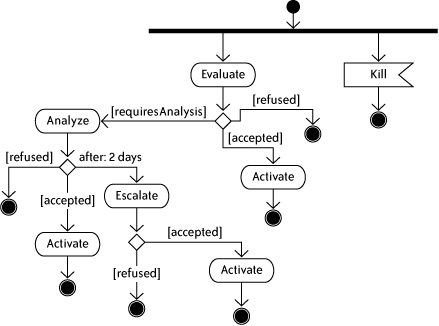Chapter Ten. Example: Human Workflow in Insurance Claims Processing
IN THIS CHAPTER (AND THE NEXT), WE WILL BUILD FEATURE-RICH, working examples that demonstrate some of the key concepts of process modeling. This chapter shows the design of a BPEL insurance claims process that is driven by human workflow, or by human participants performing manual activities. (See the section "Human Interaction" in Chapter 2 for a discussion of human workflow architecture.)
The process is implemented in Oracle BPEL Process Manager , a BPEL 1.1-compliant runtime engine that includes a design editor, an administrative console, and a human task manager subsystem; this chapter provides everything you need to know to download, install, and configure a working environment for the example.[*]
The UML activity diagram in Figure 10-1 provides a high-level overview of the behavior of the insurance process .
When the process begins, the Evaluate activity is started, which represents
manual work in which an insurance agent examines the details of the
claim and decides whether to accept or reject it outright, or to pass it
to an adjuster for further analysis, as part of the
 |
Analyze activity. That activity
can also result in an acceptance or refusal, and it can also time out if
not completed in two days. The time-out triggers a transition to the
Escalate activity, ...
Get Essential Business Process Modeling now with the O’Reilly learning platform.
O’Reilly members experience books, live events, courses curated by job role, and more from O’Reilly and nearly 200 top publishers.

